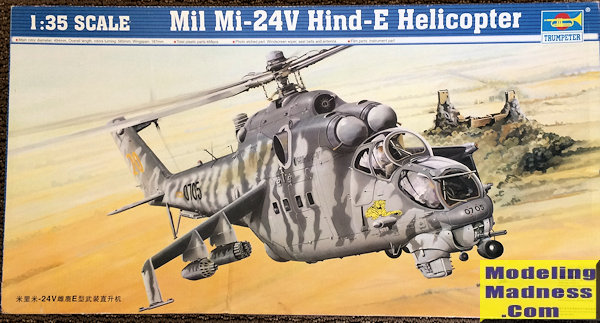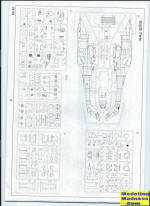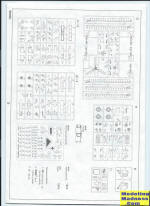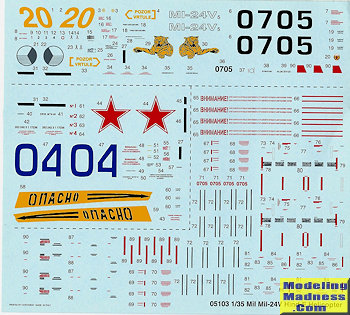
Trumpeter 1/35 Mil Mi-24V Hind-E
| KIT #: | 05103 |
| PRICE: | $90.00 or so |
| DECALS: | Two options |
| REVIEWER: | Donald Zhou |
| NOTES: |
Advantages: Well detailed, full complete weapon fit, and Big. Disadvantages: Big, BIG, and DID I mention that it is BBBIIIGGG? |

| HISTORY |
The initial design was based on a twin engine concept developed since 1966. A number of changes were made at the insistence of the military. One was the capability of carrying eight troops in a cabin behind the cockpit. Other changes included changing the 23mm cannon to a rotary 12.7mm heavy rotating machine gun and the ability to carry the new AT-6 Spiral anti-tank missile. Testing began in 1969, during which various other things were also changed including tail rotor being shifted from right to left, structural strength was further strengthened, and anhedral were added to the wings to prevent dutch rolls. These and other refinements finally resulted in the first practical version, Mi-24A being produced in 1970. The helicopter achieved initial operational capacity in 1972. The biggest external differences between the A and the later variants was the fact it did not have the iconic Hind “double warty bulge” canopy. Rather, it sported an angular greenhouse canopy instead.
The core of the helicopter, like the AH-1 borrowing heavily from the UH-1 Huey, was directly copied from the Mi-8 Hip utility helicopter. These includes the engines, main transmission, and rotor system. Unlike the Hip, the cockpit was tandem, with the pilot sitting above the co-pilot/gunner in the second seat, just in front of a small cabin which can seat up to eight fully armed troopers. The engines and rotor system is mounted above the cabin with retracting landing gears. A 12.7mm rotary cannon mounted on a turret is in front of the nose, with sighting and guidance systems beside it. Further weapons can be mounted onto two stub wings mounted mid-ship just above and behind the cabin doors with three pylons on each. Weapons eventually includes various rocket pods, cannon pods, bombs, fuel tanks and anti-tank missiles.
The fuselage and rotors are also heavily armored and are able to resist hits up to 12.7mm or .50 cal rounds. The cockpit glazing are also capable of resisting 12.7 mm hits. In fact, during Afghanistan, it was quickly found unless the helicopter was hit with anything bigger than a 23mm round, it will just shrug off hits after hits from smaller caliber weapons. The helicopter was built for speed with retractable tricycle landing gears and a streamlined body.
Nearly as soon as it entered service, the Mi-24, NATO code name Hind found itself in battle. In fact, the number of conflicts this helicopter participated or is STILL participating IN is too numerous to count and definitely way too much to list here. But the most famous definitely would be Soviet invasion of Afghanistan in 1979.
As soon as the Soviet invaded, Hinds soon followed. In a total sense of irony, Afghanistan soon proved to be similar to Vietnam. In this case, the harsh terrain are various mountains, gullies and hills that dot the landscape. Hot and dusty condition soon drove both men and machines crazy. With few roads about, and any passable roads are easy “choke points” just waiting for an ambush, the war soon became another “helicopter war” and as the Soviets found out, fast jets just did not have the time on target or the accuracy involved to do ground attack or troop support. Hinds soon found themselves either escorting Hips to targets or doing most of the heavy troop support or ground attacks. Troops love it because of its accuracy and time on target and the Mujahedeen fighters hate it for the same reasons. In fact, Mujahedeens call the Hind, “Shaiten-Arba” or Satan’s chariot. It’s one of the only two aerial weapons they fear. The other being the SU-25 Frogfoot. And as Afghanistan soon turned into indeed to be Soviet’s own version of the Vietnam War, more and more Hinds were thrown into the fray. Like the U.S. in Vietnam, Hinds soon found themselves operating with Hips in “Hunter-Killer Parties” to seek out and destroy the elusive Mujahedeen.
Attritions soon started to add up. One thing the crews learned quickly was the troop carrying capability was pretty redundant. The dry, hot condition already ruined the engine capacity so the cabin armor was quickly removed and sometimes even the seats to save weight. Troop carrying was left to the Hips although crews quickly found out the empty spaces can be used to carry spare rocket rounds, a favorite weapon of the Hind crews and a single “technician” to operate a machine gun or two, like the Huey door gunners to defend the helicopter sides. Despite the losses, Hinds enjoyed quite the supremacy over the Mujahedeens. There is one story where a Hind crew, out of ammo, made a fake “swan” dive onto a group of fighters to drive them off before making a quick landing to pick up some stranded Soviet troopers trapped by them. Such was the fear generated by the “Satan’s Chariot”.
That however, changed quickly in
1986. That year, under clandestine operations carried out by the CIA, U.S. made
FIM-92 Stinger MANPADS or MAN Portable Air Defense missiles were slowly but
surely given to the Mujahedeens. Unlike previous Redeye or similar Soviet made
missiles captured by the Israelis during their various wars with their Arab
neighbors and given to them, the Stingers were another story. Its inferred
guided nose is much more sensitive and harder to jam and can lock on from all
aspects, rather than just the tail. The first Hind shot down by a Stinger was
lost that same year and losses quickly mounted even though there are arguments
to the numbers of losses generated by the Stingers. The effect of the MANPAD
though, is quite evident as all helicopters, not just Hinds were modified with
chaff and flare dispensers, IR jammers and exhaust suppressors. The Hinds soon
found themselves an incredibly dangerous duty, escorting aircrafts in and out of
Kabul Airport by throwing out flares left and right and hopping they would work.
The crews wryly called themselves “mandatory Matrosovs”, after a Great Patriotic
War hero who threw himself in front of a German machine gun nest so his comrades
can advance. In the end, in 1989, ten years after the Invasion, the Soviets were
forced to withdraw and like the Americans, retreated with their tails between
their legs. The last Hind was lost in Feb. of that year, it was also the last
loss of any Soviet helicopter during the war. Unlike the American, the Soviet
economy, already on its last strings, took such a mortal blow that three years
later, the entire USSR folded and ceased to exist. This conflict, and another
one that took place near the same time now mostly forgotten by the West, the
“Two I” or Iran and Iraq War, which made history when Hinds and Iranian Cobras
were involved in the first and only helicopter vs. helicopter dogfights cemented
the Hinds place in the annals of warfare.
| THE KIT |

 Trumpeter’s big Hind was actually
released in 2006 and I bought it 2010. Meant to do a preview much sooner but as
things sometimes works, it dragged out until now.
Trumpeter’s big Hind was actually
released in 2006 and I bought it 2010. Meant to do a preview much sooner but as
things sometimes works, it dragged out until now.
The kit comes in a rather large box filled with around 451 parts in which over 160 are for the weapons, 14 clear pieces and 44 photo-etch parts! Just how long this thing is? The fuselage halves fill the length from the left to right with no inches to spare! Add in the rotors and now you better prepare a rather huge space to display this thing!
Details are excellent. Remember this is before the advent of “slide-molding” technology so the details, although may not be to par against modern molding, still stands quite well on its own. The kit features a detailed cockpit with detailed canopy (hell, even the small crew cooling fan is represented by a photo etch part!), a good cabin with troop seats (I would say the only lacking parts are the seat belts. But then again, was seat belts even given to the troopers?), two monstrous detailed engines can be displayed behind clear parts that have no mould spots or ejector pin marks! The external details are just as good but like the engines, you can really go to town with scratched details such as tubings etc.
As come out of the box, the kit can be built to represents a mid to late production Mi-24V Hind E with features such as the AT-6 Missile Guidance pod, the two RHAW sensors mounted on the forward fuselage sides and the search/landing light on the Port side, the RHAW sensor mounted on the Gun Camera faring and the top mounted IR Jammer as well as the mounting plates for the engine exhausts IR suppressors although there are no suppressors in the kit and an extensive suite of antenna and aerials for the Hind E. The only thing missing are perhaps the chaff and flare dispensers and the mentioned exhaust suppressors but since not all Hind E’s were fitted with them, it does not distract from the kit.
Construction begin with the cockpit. Seat belts are not provided but the buckles are so you can use your favourite medium to create them. The instruments are the old “sandwich” type in which a filmed instrument panel is trapped between a backing and clear part. It still does work. There are a lot of parts so take your time to assemble and have fun painting as some Hind cockpit are quite dirty!
Next are the two Isotov TV3-117 engines and these are quite detailed with various assemblies and pippings. The only things needed are all the wirings that festoon these things. You can display them by either open the engine hatches or use the clear engine hatch parts.
The next major assemblies, after some accessories assembly are the wings and the pylons. Quite a bit of parts goes here so do take your time.
The landing gears are next. Strangely, tires are plastics and they are separate from the wheel hubs so this should make people who hate vinyl happy. Machine gun assembly and its associated turret is next. Careful reading of instructions will make sure they work later.
Now, various parts you have assembled now goes on the fuselage before they come together. Just be careful with cabin doors. Do not attach the hinges if you are keeping the doors closed. Same with the engine maintenance access hatch. You can keep them closed since they are clear but it can be also opened if you want to colour them, as most serious modellers will do.
Attachment of the wings, tail rotors and horizontal stabilizers are next.
After dealing with some accessories, the cockpit is next. Do be careful with crew cooling fan’s fan blade. It’s photo-etch and it’s quite small. More photo-etch brass for the windshield wipers are also needed to be bend and attached to the cockpit doors and front of the canopy before all is done.
Various attachments including the sighting and guidance unit, machine gun ammo box, and landing gear doors now go on the fuselage before the rotor assembly finally concludes the model….And no, it’s not over yet!
Now comes the weapons that can be attached to those six pylons. Just remember the wingtip ones are for anti-tank weapons only and the weapon suite are extensive! Just about every weapons cleared to be carried by a Hind are included in the kit. Here is a major run down:
Two FAB-50 Bombs
Two FAB-100 Bombs
Four FAB-250 Bombs
Two FAB-500 Bombs
Two OFAB-100 Bombs
Two OFAB-250 Bombs
Two ZAB-100 Bombs
Two ZAB-500 Bombs
Two KMGU-2 Cluster Bombs
Four PTB-450 Fuel Tanks
Two 9-A-669 Grenade Launcher (which can be built into a 9-A-624 triple Gun Pod)
Two UPK-23 250 Twin Cannon Pod
 Four UB-32A-24 Rocket Pods
Four UB-32A-24 Rocket Pods
Four B8V20 Rocket Pods
Four 9M17P Falanga Anti-Tank Missiles (AT-2 Swatter)
Four 9M114 Sturm Anti-Tank Missiles (AT-6 Spiral)
As you can see, there are quite a lot of weapons, enough for a squadron of Hinds! An extensive list of decals are included for ALL of them! The only thing missing is if you want to attach the AT-2 Swatters, you need to home build the wirings associated with them.
Two color schemes are included. The first one is for a Russian bird at the Brandenburg-Berlin right after the USSR collapsed and the other is a Czech bird participating in the 1998 Tiger Meet with a very bold Neutral Grey over Light Ghost Grey “tiger stripe” scheme.
| CONCLUSIONS |
What can I say? If you wanna sink your teeth into something big and whirly, then this kit is for you. Currently, both Cobra and Verlinden and other third party companies have developed resin kits for various stuff like cockpits, cabins and others. However, the kit parts is good enough and you can build a contest winner right out of the box. Extra decals though, can be a good consideration if you are especially looking at a Soviet Afghanistan bird. All in all, this kit is a great jumping off point as the basic airframe is the basis for export Mi-35, which are sold to over dozens of countries with some very exotic paint schemes! The only big tripping point is its size. There is a reason why it stayed in the box since 2010 when I bought it! It’s BIIIIG and you can take that home to bat with it! Come to think of it, if I ever get around to it, I would buy a metal rod to replace the rotor shaft and then leave the rotor most of the time on its side! That’s the only way to save space with this monster!
P.S. If you are looking for a Hind that is smaller, Hobbyboss, aka, Trumpeter under a different name, offers a 1/72 scale Hind kit that is excellent. It should since it’s basically a “dumbed down” copy of this kit!
March 2016
Thanks to me for getting this one on sale.
If you would like your product reviewed fairly and fairly quickly, please contact the editor or see other details in the Note to Contributors.